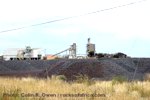Poldervaartite / Olmiite Info
Back to Poldervaartite
Back to Olmiite
 |
| N'Chwaning II Mine |
Poldervaartite - Olmiite Discussion
The newest identified mineral (from the N’Chwaning II Mine) is olmiite which is closely associated with poldervaartite. Olmiite crystals alledgedly occur as wheat-sheaf aggregates. Its colors are similar to Poldervaartite, it has a density of 3.05, in contrary to Poldervaartite (2.91). Olmiite contains more Mn than poldervaartite. If Ca is dominant, it is poldervaartite.
In 2006 / 2007 the Earth Science Department of the University of Florence / Italy carried out some investigations to determine if the new mineral from the N'Chwaning II mine is indeed poldervaartite. The results of this investigation are reported in detail by Bonazzi et al. (2007): The N'Chwaning II samples were a new species, the Mn-dominant analog of poldervaartite within a poldervaartite-olmiite-series. The International Mineralogical Association (IMA) approved it with the name "olmiite" in honor of Filippo Olmi (CNR-Istituto di Geoscienze e Georisorse of Florence / Italy).
The examinations (with electron microscope, quantitative analyses etc.) of about 25 specimens from N'Chwaning II Mine, representing all available crystal habits, aggregates, colors etc. indicated that most or all specimens were olmiite.
Because many crystals show a pink inner core and an almost colorless outer layer, the central areas as well as the outer rim of the crystals were also examined. My conclusion: The more intense the color the more Mn content, which means that the more intense the color, the more it should be olmiite.
Although crystals from the Wessels Mine contain Ca as well as Mn, it can be said that they are most likely poldervaartite, but sometimes olmiite. N'Chwaning II Mine crystals seem to be more Mn dominant which means that all of them seem to be olmiite.
Source: www.articlearchives.com
Formation
Poldervaartite / olmiite was probably formed from sediments in hydrothermal fluids which contained Ca, SiO2, and CO2. As mentioned above, poldervaartite contains more Ca than olmiite which is the Mn-dominant analogue of poldervaartite. Until now both varieties are only found in South Africa.
Resources
The only resources are the mines in the Kalahari Manganese Fields, located approximately 60 kilometers northwest of Kuruman: the Wessels Mine, and the N'Chwaning I (closed), II and III Mines.
Color
Before olmiite was discovered (in 2006), poldervaartite was known as opaque, partially transparent, whitish, cream-colored aggregates from the Wessels mine and N'Chwaning I. Then, in 2006, gemmy, transparent, reddish specimens from the N'Chwaning II mine were dicovered, described in 2007, and accepted as a new, Mn-dominant analogue of poldervaartite, now called olmiite.
Quality
The more transparent the more expensive, like other gemstones. Isolated crystals of poldervaartite / olmiite are rare. They usually occur as nice round aggregates, up to approximately 3 cm - sometimes even slightly larger.
⇐ Intro Page ⇐ Gemstones ⇐ Olmiite ⇐ Poldervaartite